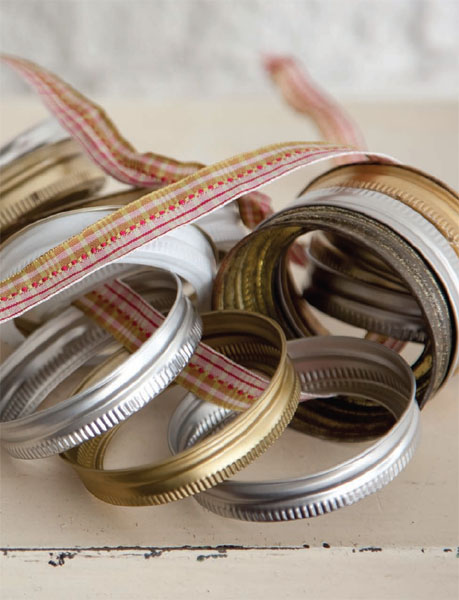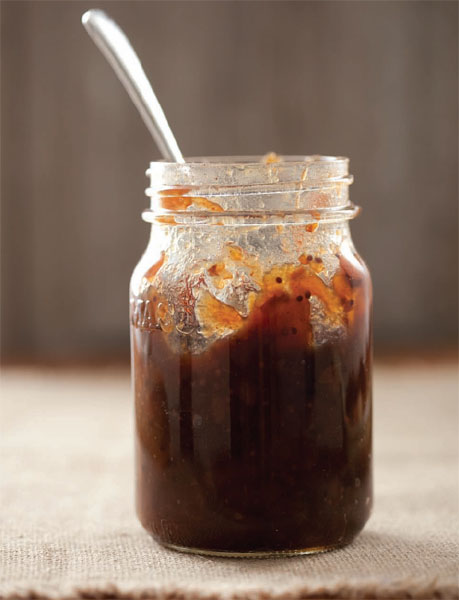Food in Jars (16 page)
Authors: Marisa McClellan
W
HEN I FIRST MADE THIS CONSERVE, I WASN'T
sure what to do with it. It had the punchy bitterness of marmalade, but with the texture of a relish. However, soon enough, it had grown on me to the point where I couldn't imagine eating roast chicken without a dab. It's wonderful around the holidays, when most people have a surplus of baked ham and roast turkey.
3 cups/300 g fresh cranberries
1 cup/240 ml orange juice
1 whole orange, seeded and finely chopped
1 tart apple (such as Granny Smith), peeled, cored, and minced
12 dried apricots, chopped
½ cup/120 ml honey
2 cups/400 g granulated sugar
½ cup/70 g slivered almonds
½ teaspoon ground ginger
Prepare a boiling water bath and 5 half-pint/250 ml jars according to the process on page 10. Place the lids in a small saucepan, cover them with water, and simmer over very low heat.
Combine the cranberries, orange juice, and chopped orange in a large, nonreactive pot. Bring to a simmer over medium-high heat and let cook until the cranberries begin to burst, about 10 minutes.
Add the chopped apple, apricots, honey, and sugar and increase the heat to high. Cook for about 20 minutes, until the orange rinds are tender and the mixture has thickened. When it reaches a thick, spreadable consistency, remove the pot from the heat and stir in the chopped almonds and ginger.
Ladle the conserve into the prepared jars, leaving
½
inch/12 mm headspace. Wipe the rims, apply the lids and rings, and process in a boiling water bath for 10 minutes (see
page 11
).



D
URING MY FIRST TEN YEARS OF LIFE, I HELD FAST
to a strict condiment matrix. Mustard went on hot dogs. Ketchup belonged with hamburgers and French fries (meatloaf was also an acceptable vehicle). Mayonnaise was only good as a dipping sauce for steamed broccoli or asparagus. Salad dressing was Italian and made from a packet on which the words “Good Seasons” were emblazoned. Blueberry or plum jam went on buttered toast and honey went with peanut butter. Chutney, hot sauce, and relish didn't exist for me.
As I got older, I became aware of the wider world of condiments and my matrix started to crumble. The introduction of soy and teriyaki sauces caused the initial cracks and sweet red chili sauce dealt the final blow.
Now I'm an equal opportunity condiment user and the bulk of the precious real estate on our refrigerator door is devoted to housing the assorted bottles and jars (sadly, my husband is still strictly a ketchup and Thousand Island dressing guy).
Here are just a couple of tips as you tackle these condiment recipes. Chutneys and ketchups will always take longer to cook down than you might think possible. They also need more stirring than you might think reasonable, so stay close and plan for other kitchen projects to keep you occupied as you wait for them to thicken.
Mustards are incredibly easy to make, but just like pickles, they need a chunk of time to cure before they'll be ready to eat. Don't be discouraged if your mustard is both bitter and bland at first. I promise it will age into something worthy of that artisanal sausage.
Finally, if you plan on taking a chutney to a potluck or party, I recommend opening it at least an hour prior to serving. Just like wine, chutney needs a bit of time to breathe. Otherwise, all you'll taste is the vinegar.

T
HIS CHUTNEY MAKES AN EXCELLENT POTLUCK CONTRIBUTION
when paired with a log of goat cheese and a tender baguette. It's adapted from the rhubarb chutney recipe in
The New York Times Heritage Cookbook
that was printed in 1971 and edited by Jean Hewitt.
6 cups sliced rhubarb (about 2 pounds/910 kg rhubarb stalks)
3 cups/345 g sliced onion (2 medium onions)
1 cup/170 g raisins
3 cups/600 g (packed) light brown sugar
2 cups/480 ml apple cider vinegar
1 tablespoon salt
1 teaspoon ground cinnamon
1 teaspoon ground ginger
½ teaspoon mustard seed
½ teaspoon ground cloves
½ teaspoon red pepper flakes
â
teaspoon cayenne pepper
Prepare a boiling water bath and 3 regular-mouth 1-pint/500 ml jars according to the process on page 10. Place the lids in a small saucepan, cover them with water, and simmer over very low heat.
Combine all ingredients in a large pot and bring to a boil. Reduce the heat and simmer gently until the mixture is thick and sticky, stirring regularly for 45 to 75 minutes. You'll know it's done when all the ingredients have come together in a uniformly brown mash (chutney always tastes better than it looks).
When the chutney is finished cooking, ladle it into the prepared jars, leaving
½
inch/12 mm of headspace. Wipe the rims, apply the lids and rings, and process in a boiling water bath for 15 minutes (see
page 11
).
Note:
The cooking times for chutneys can vary drastically depending on the width of your pot, the amount of humidity in the air, and the water content of the ingredients. The goal is to cook it down until it is thick and any remaining liquid is syrupy. Give it plenty of time and stir it regularly to ensure that it does not burn.

A
COUPLE SUMMERS AGO, I PROMISED TO TEACH A
canning class in which we'd make a spicy tomato chutney. At the time, of course, I had no such recipe and so spent the weeks before the class making a progression of batches before hitting upon a winner. This one, with its Indian-inspired palette of flavors was far and away the most delicious and interesting. Now, I make it each year for nibbling and gift giving.
2 teaspoons mustard seed (brown or black)
2 teaspoons fennel seed
2 teaspoons celery seed
1 teaspoon coriander seed
â
teaspoon cayenne pepper
2½ cups/600 ml distilled white vinegar
2 cups/400 g granulated sugar
5 pounds/2.3 kg plum or Roma tomatoes, peeled, cored, and chopped (see
page 164
for peeling instructions)
1 teaspoon salt
In a dry skillet, toast together the mustard, fennel, celery, and coriander seeds over medium heat until they begin to pop and smell fragrant, about 3 minute. Pour the seeds into a small bowl and combine with the cayenne. Set aside.
In a large pot, combine the vinegar and sugar and simmer over high heat until the sugar dissolves. Add the tomatoes and the seeds. Stir to combine and bring to a boil. Reduce heat to medium and cook, stirring often, until the tomatoes have reduced and developed a thick, spreadable consistency, about 1 to 1
½
hours.
After the chutney has cooked for approximately 45 minutes to 1 hour, prepare a boiling water bath and 3 regular-mouth 1-pint/500 ml jars according to the process on page 10. Place the lids in a small saucepan, cover with water, and bring to a simmer over very low heat.
When the chutney is finished cooking, ladle it into the prepared jars, leaving ½ inch/12 mm of headspace. Wipe the rims, apply the lids and rings, and process in a boiling water bath for 15 minutes (see
page 11
).
